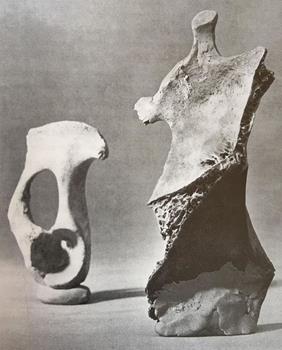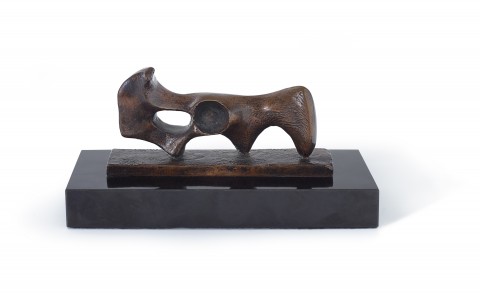MAQUETTE FOR RECLINING FIGURE: CIRCLE, 1983
HENRY MOORE
bronze, brown patina
7.5 x 15.5 x 4.5 cm
signed and numbered on base: Moore 8/9
Private collection, USA, acquired directly from the artist
Lillian Heidenberg Fine Art, New York (label attached to base)
Private collection, Melbourne, acquired from the above in December 2003
Henry Moore, Fonds Hélène & Édouard Leclerc pour la Culture, Landerneau, France, 10 June – 4 November 2018 (another example)
Bowness, A., (ed.) Henry Moore, Complete Sculpture 1949 – 54, London, 1986, vol. 6, cat. LH 902, pl. 127 (illus. another example)
Another example of this cast is held in the collection of the Henry Moore Foundation, United Kingdom
Reclining Figure: Circle, 1983, plaster, 7.5 × 15.7 × 4.4 cm, held in the collection of the Henry Moore Foundation, United Kingdom
Reclining Figure: Circle, 1983, bronze, 43.2 x 88.9 cm, edition of 9, held in the collection of the Los Angeles County Museum, Los Angeles, USA
HENRY MOORE.jpg

Henry Moore OM CH (1898 – 1986) is regarded today, as he was during his lifetime, as one of Britain’s greatest Modernist artists, with his sculptures known and admired around the world. Approaching the subject of the reclining human form with a radical revision of figurative representation, Moore came to symbolise the resilience and inventiveness of the English people in the wake of the wars of the early 20th century. Founded on organic and mineral forms, his sculptures contain familiar shapes that are then transformed and rearranged into semi-abstract figurative compositions, anonymous and universally resonant. Almost completely divorced from a recognisable figurative form, Reclining Figure: Circle’s revision of this pose is bold and authoritative, unifying the many threads of artistic inquiry Moore had followed throughout his career.
Maquette for Reclining Figure: Circle, 1983 is a small editioned bronze sculpture by Henry Moore, cast from an original plaster carving (LH902, plaster, now held in the Henry Moore Foundation), and later enlarged into another editioned bronze sculpture (LH903), although never into a monumental format. A quintessentially modern artist, Henry Moore created sculptures which rarely refer to their geographical environment, and can exist independently as small objects, to inhabit in private spaces as well as in grand, public ones.
Reduced to the most condensed ratio of proportions and directional lines, the format of a reclining female figure with knees bent, resting on her elbow, is only barely discernible within this maquette. Moore has created a dramatic transformation of smooth curves, crests and pointy accretions into the silhouette of a human being. Although modest in size, paradoxically, Henry Moore’s composition of Reclining Figure: Circle was constructed with the intention of monumentality. As the artist himself explained: ‘everything I do is intended to be big, and while I’m working on the models, for me they are life size. When I take one in my hand like this, I am seeing and feeling it as life size… so in my mind there’s never any change of scale at all’.1
Moore’s oeuvre is underpinned by the concepts of transformation and metamorphosis, using organic objects as stimuli, combined with a Jungian theory of archetypal images and collective unconscious.2 His works in sculpture, drawing and print reveal this tightly cohesive visual thesis. From the 1930s, Moore sought the true essence of form within nature and mathematics. He used the ‘raw materials’ of found items such as weathered flint stones, shells, and bones, displayed in vast collections on the shelves of his maquette studio in Perry Green, Hertfordshire. The 1930s were a period of extraordinarily creative experimentation for Moore, sadly suspended in a preparatory state over the years of the second world war and only revisited much later in works such as this Reclining Figure: Circle.
Pencil and ink drawings held in Moore Foundation demonstrate the clear development of ideas through a progressive reduction of form. Photographs and drawings from his studio dating back at least to 1961 reveal the exact organic stimulus for Reclining Figure: Circle, a hipbone of a sheep [fig. 1]. This shape appears in several charcoal and ink studies and finally was copied in 1983 into the plaster sculpture from which this bronze was cast. The clearest example can be found in Idea for sculpture: Bone Form, 1983 (HMF 83 (129) and HMF 83(77)), although scholars at the Henry Moore Foundation have suggested these may have been drawn from the finished sculpture as opposed to being preparatory sketches.3
The classical ideal of the reclining nude was a recurrent theme within Henry Moore’s oeuvre, generating many masterpieces, including Reclining Figure, 1935 – 1936 (elmwood, Albright-Knox Art Gallery, Buffalo) and Reclining Figure, 1951 (bronze, National Galleries of Scotland). With its advanced formal abstraction, the innovation that distinguishes Maquette for Reclining Figure: Circle from previous investigations of the format was the inclusion of two holes directly copied from the mammalian pelvic bone in Moore’s studio: the perforation of the obturator foramen and the ball socket joint of the femur. The spherical indentation of this ball socket, with sharp edges around the rim, is the circle of this work’s title. The original plaster form of Reclining Figure: Circle was scored and filed to mimic the texture of the original bone, contrasting with the rounded rhythmic arches that anchor the sculpture to its base and its uppermost crests. When cast in bronze, these textures remain apparent, only now gleaming with a dynamic tension. Reclining Figure: Circle, while fixed in its heavy bronze materiality, is delicately poised on three points of contact, and the viewer’s eye is instinctively drawn through these voids and back through the form, giving multiple points of view of the form at once, verifying Moore’s claim that ‘The hole connects one side to the other, making it immediately more three-dimensional.’4
1. Henry Moore, interview with Donald Hall, 1960, quoted in Alan Wilkinson (ed.), Henry Moore: Writings and Conversations, Aldershot 2002, p. 208
2. Calvocoressi, R., director of the Henry Moore Foundation, quoted in ‘Henry Moore Wunderkammer Origin of Forms’, Gagosian, London, February – April 2015, p. 78
3. Henry Moore Foundation online catalogue [https://catalogue.henry-moore.org/objects/12112/reclining-figure-idea-fo... (accessed 4/11/21)
4. Moore, H., ‘The Sculptor Speaks’, Listener, London, 18 August 1937, pp. 338 – 40
LUCIE REEVES-SMITH
